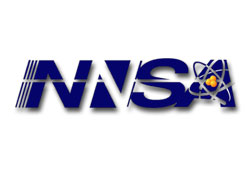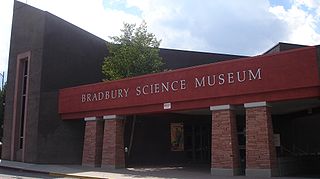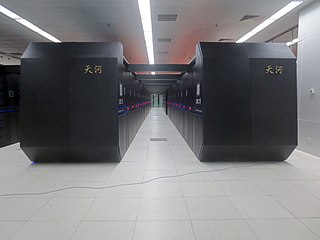
A supercomputer is a computer with a high level of performance as compared to a general-purpose computer. The performance of a supercomputer is commonly measured in floating-point operations per second (FLOPS) instead of million instructions per second (MIPS). Since 2017, there are supercomputers which can perform over 1017 FLOPS (a hundred quadrillion FLOPS, 100 petaFLOPS or 100 PFLOPS). Since November 2017, all of the world's fastest 500 supercomputers run Linux-based operating systems. Additional research is being conducted in the United States, the European Union, Taiwan, Japan, and China to build faster, more powerful and technologically superior exascale supercomputers.

Los Alamos National Laboratory is a United States Department of Energy national laboratory initially organized during World War II for the design of nuclear weapons as part of the Manhattan Project. It is located a short distance northwest of Santa Fe, New Mexico, in the southwestern United States.

Oak Ridge National Laboratory is an American multiprogram science and technology national laboratory sponsored by the U.S. Department of Energy (DOE) and administered, managed, and operated by UT–Battelle as a federally funded research and development center (FFRDC) under a contract with the DOE. Established in 1942, ORNL is the largest science and energy national laboratory in the Department of Energy system and third largest by annual budget. ORNL is located in the Roane County section of the city of Oak Ridge, Tennessee. ORNL's scientific programs focus on materials, neutron science, energy, high-performance computing, systems biology and national security.

In computing, floating point operations per second is a measure of computer performance, useful in fields of scientific computations that require floating-point calculations. For such cases it is a more accurate measure than measuring instructions per second.

Blue Gene is an IBM project aimed at designing supercomputers that can reach operating speeds in the petaFLOPS (PFLOPS) range, with low power consumption.

Stockpile stewardship refers to the United States program of reliability testing and maintenance of its nuclear weapons without the use of nuclear testing.

ASCI Red was the first computer built under the Accelerated Strategic Computing Initiative (ASCI), the supercomputing initiative of the United States government created to help the maintenance of the United States nuclear arsenal after the 1992 moratorium on nuclear testing.

ASCI Blue Mountain is a supercomputer installed at the Los Alamos National Laboratory in Los Alamos, New Mexico. It was designed to run simulations for the United States National Nuclear Security Administration's Advanced Simulation and Computing program. The computer was a collaboration between Silicon Graphics Corporation and Los Alamos National Laboratory. It was installed in 1998.

The Advanced Simulation and Computing Program is a super-computing program run by the National Nuclear Security Administration, in order to simulate, test, and maintain the United States nuclear stockpile. The program was created in 1995 in order to support the Stockpile Stewardship Program. The goal of the initiative is to extend the lifetime of the current aging stockpile.

The Bradbury Science Museum is the chief public facility of Los Alamos National Laboratory, located at 1350 Central Avenue in Los Alamos, New Mexico, in the United States. It was founded in 1953, and was named for the Laboratory's second director (1945-1970), Norris E. Bradbury. Among the museum's early exhibits, artifacts and documents from World War II Manhattan Project were displayed upon declassification. Other exhibits include full-size models of the Little Boy and Fat Man atomic bombs. Admission is free.

Open MPI is a Message Passing Interface (MPI) library project combining technologies and resources from several other projects. It is used by many TOP500 supercomputers including Roadrunner, which was the world's fastest supercomputer from June 2008 to November 2009, and K computer, the fastest supercomputer from June 2011 to June 2012.

Roadrunner was a supercomputer built by IBM for the Los Alamos National Laboratory in New Mexico, USA. The US$100-million Roadrunner was designed for a peak performance of 1.7 petaflops. It achieved 1.026 petaflops on May 25, 2008, to become the world's first TOP500 LINPACK sustained 1.0 petaflops system.

The TOP500 project ranks and details the 500 most powerful non-distributed computer systems in the world. The project was started in 1993 and publishes an updated list of the supercomputers twice a year. The first of these updates always coincides with the International Supercomputing Conference in June, and the second is presented at the ACM/IEEE Supercomputing Conference in November. The project aims to provide a reliable basis for tracking and detecting trends in high-performance computing and bases rankings on HPL, a portable implementation of the high-performance LINPACK benchmark written in Fortran for distributed-memory computers.
Cielo, El Cielo, or Il Cielo (Italian) may refer to:
High Performance Storage System (HPSS) is a flexible, scalable, policy-based Hierarchical Storage Management product developed by the HPSS Collaboration. It provides scalable hierarchical storage management (HSM), archive, and file system services using cluster, LAN and SAN technologies to aggregate the capacity and performance of many computers, disks, disk systems, tape drives and tape libraries.
In computing, performance per watt is a measure of the energy efficiency of a particular computer architecture or computer hardware. Literally, it measures the rate of computation that can be delivered by a computer for every watt of power consumed. This rate is typically measured by performance on the LINPACK benchmark when trying to compare between computing systems.
Exascale computing refers to computing systems capable of calculating at least 1018 floating point operations per second (1 exaFLOPS). The terminology generally refers to the performance of supercomputer systems and although no single machine has reached this goal as of June 2020, there are systems being designed to reach this milestone. In April 2020, the distributed computing Folding@home network attained one exaFLOPS of computing performance.

Appro was a developer of supercomputing supporting High Performance Computing (HPC) markets focused on medium- to large-scale deployments. Appro was based in Milpitas, California with a computing center in Houston, Texas, and a manufacturing and support subsidiary in South Korea and Japan.

Tianhe-2 or TH-2 is a 33.86-petaflops supercomputer located in the National Supercomputer Center in Guangzhou, China. It was developed by a team of 1,300 scientists and engineers.













